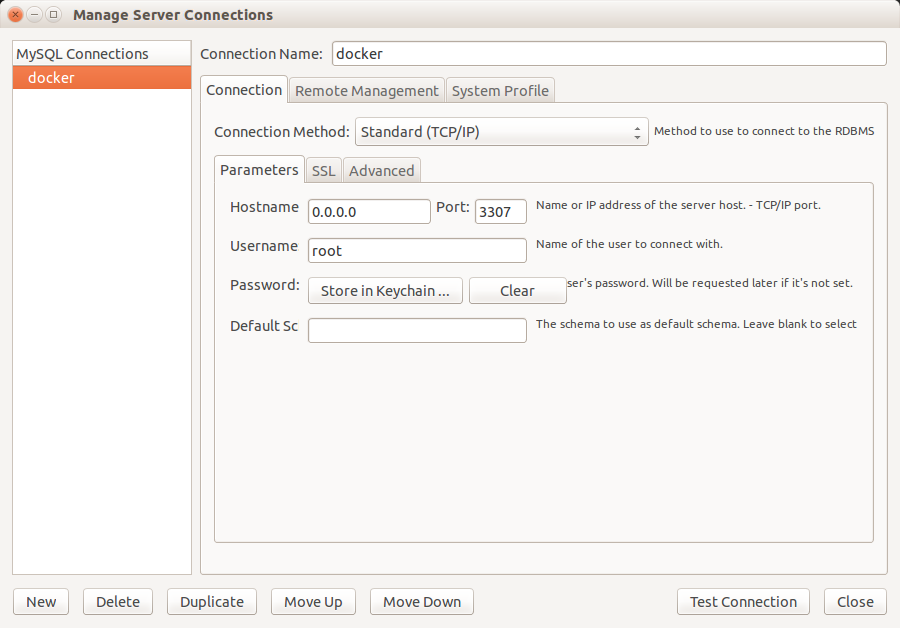visay / dockertypo3
Docker Compose structure to quickly startup TYPO3 CMS projects
Installs: 2 535
Dependents: 0
Suggesters: 0
Security: 0
Stars: 1
Watchers: 3
Forks: 7
Open Issues: 3
Language:Shell
pkg:composer/visay/dockertypo3
Requires
- typo3/cms: *
This package is not auto-updated.
Last update: 2025-12-19 20:39:04 UTC
README
DockerTYPO3 creates the necessary Docker containers (webserver, database, php, mail, redis, elasticsearch, couchdb)
to run your TYPO3 CMS project. The package provides a wrapper script in vendor/bin/dockertypo3
which simplifies the handling of docker and does all the configuration necessary.
We created this package to make development on TYPO3 CMS projects easier and to create a simple reusable package which can easily be maintained and serves well for the standard project.
Development will continue further as the package is already reused in several projects. Contributions and feedback are very welcome.
Install docker
https://docs.docker.com/installation/ (tested with docker v1.9 - v1.12)
Install docker-compose
We use docker-compose to do all the automatic configuration:
http://docs.docker.com/compose/install/ (tested with docker-compose v1.5 - v1.6)
The repository contains a Dockerfile which will automatically be built in the docker hub after each change and used by docker-compose to build the necessary containers.
On a Mac or Windows
It has been tested working with docker for Mac but not yet with docker for Windows. Feel free to try out and let me know if you cannot wait.
Install dockertypo3 into your distribution
Add visay/dockertypo3 as dev dependency in your composer, using the latest stable release is highly recommended.
Example:
composer require --dev visay/dockertypo3 2.1.*
Note:
DockerTYPO3 uses port 80 for web access so you need to make sure that your host machine does not have any software using that port. Usually this happens if you have apache or nginx installed in your host machine, so you can stop it with:
sudo service apache2 stop
sudo service nginx stop
Run dockertypo3
vendor/bin/dockertypo3 up -d
The command will echo the url with which you can access your project. Add the hostname then to your /etc/hosts
and set the ip to your docker host (default for linux is 0.0.0.0). You can also use any subdomain with *.hostname and
it will point to the same server. What you need to do is to add exact subdomain name to your /etc/hosts.
The parameter -d will keep it running in the background until you run:
vendor/bin/dockertypo3 stop
The default database configuration for your AdditionalConfiguration.php is:
<?php
if (!defined ('TYPO3_MODE')) {
die ('Access denied.');
}
## Database connection
$GLOBALS['TYPO3_CONF_VARS']['DB']['host'] = 'db';
$GLOBALS['TYPO3_CONF_VARS']['DB']['password'] = 'root';
$GLOBALS['TYPO3_CONF_VARS']['DB']['username'] = 'root';
$GLOBALS['TYPO3_CONF_VARS']['DB']['database'] = 'dockertypo3';
Also note that there is a second database dockertypo3_test available for your testing context. The testing context url
would be test.hostname and this hostname should be added to your /etc/hosts too.
Check the status
vendor/bin/dockertypo3 ps
This will show the running containers. The data container can be inactive to do it's work.
Tips & Tricks
Using different TYPO3_CONTEXT
TYPO3_CONTEXT=Production vendor/bin/dockertypo3 up -d
DockerTYPO3 also setup a sub-context for testing depends on the current context you are running. In the above example,
it would be Production/Testing. Anyway, you can only use the parent context with the vendor/bin/dockertypo3 command. So when
there is a need to execute command for the testing context, you need to first get into app container and then call the
command prefixed by the context variable.
TYPO3_CONTEXT=Production vendor/bin/dockertypo3 up -d
vendor/bin/dockertypo3 run app /bin/bash
TYPO3_CONTEXT=Production/Testing <YOUR COMMAND>
Configure remote debugging from your host to container
DockerTYPO3 installs by the default xdebug with the following config on the server:
xdebug.remote_enable = On
xdebug.remote_host = 'dockerhost'
xdebug.remote_port = '9001'
xdebug.max_nesting_level = 500
So you can do remote debugging from your host to the container through port 9001. From your IDE, you need to configure the port accordingly. If you are using PHPStorm, this link may be useful for you to configure your IDE properly.
Running a shell in one of the service containers
vendor/bin/dockertypo3 run SERVICE /bin/bash
SERVICE can currently be app, web, data, db, redis, elasticsearch or couchdb.
Access project url when inside app container
As of current docker doesn't support bi-directional link, you cannot access web container from app container.
But in some case you will need this connection. For example in behat tests without selenium, you need the url of
your site in Testing context while running the tests has to be done inside the app container.
DockerTYPO3 adds additional script after starting all containers to fetch the IP address of web container and
append it to /etc/hosts inside app container as below:
WEB_CONTAINER_IP project-url
WEB_CONTAINER_IP test.project-url
You need to define the default test suite url in your behat.yml to use http://test.project-url and then you can
run the behat tests without having to connect external selenium server
vendor/bin/dockertypo3 run app vendor/bin/behat -c Path/To/Your/Package/Tests/Behaviour/behat.yml
Access database inside container from docker host
While you can easily login to shell of the db container with vendor/bin/dockertypo3 run db /bin/bash
and execute your mysql commands, there are some cases that you want to run mysql commands directly
from your host without having to login to the db container first. One of the best use cases,
for example, is to access the databases inside the container from MySQL Workbench tool.
To be able to do that, we have mapped database port inside the container (which is 3306) to your
host machine through 3307 port.
Access CouchDB
From your host machine, you can access couchdb from web interface or command line:
Web: http://0.0.0.0:5984/_utils/
Cli: curl -X GET http://0.0.0.0:5984/_all_dbs
From inside your app container, you can also access couchdb through the command line:
vendor/bin/dockertypo3 run app /bin/bash
curl -X GET http://couchdb:5984/_all_dbs
Attach to a running service
Run vendor/bin/dockertypo3 ps and copy the container's name that you want to attach to.
Run docker exec -it <containername> /bin/bash with the name you just copied.
With this you can work in a running container instead of creating a new one.
Check open ports in a container
vendor/bin/dockertypo3 run SERVICE netstat --listen

